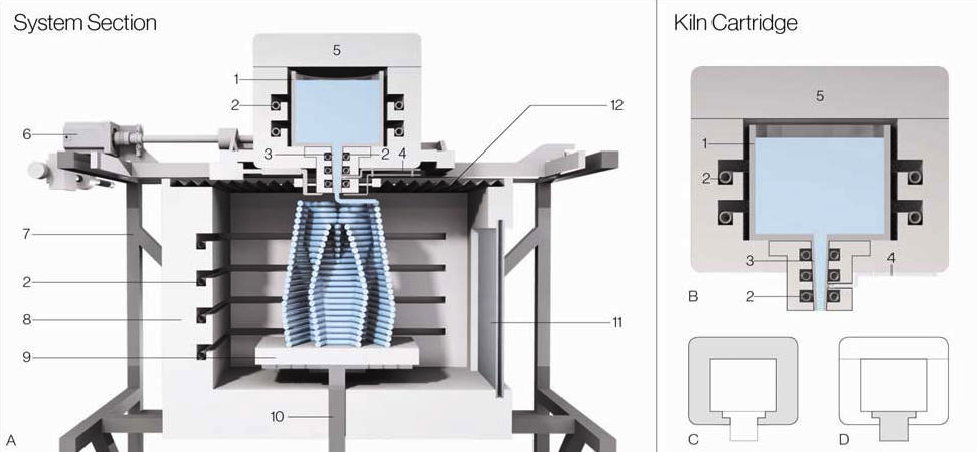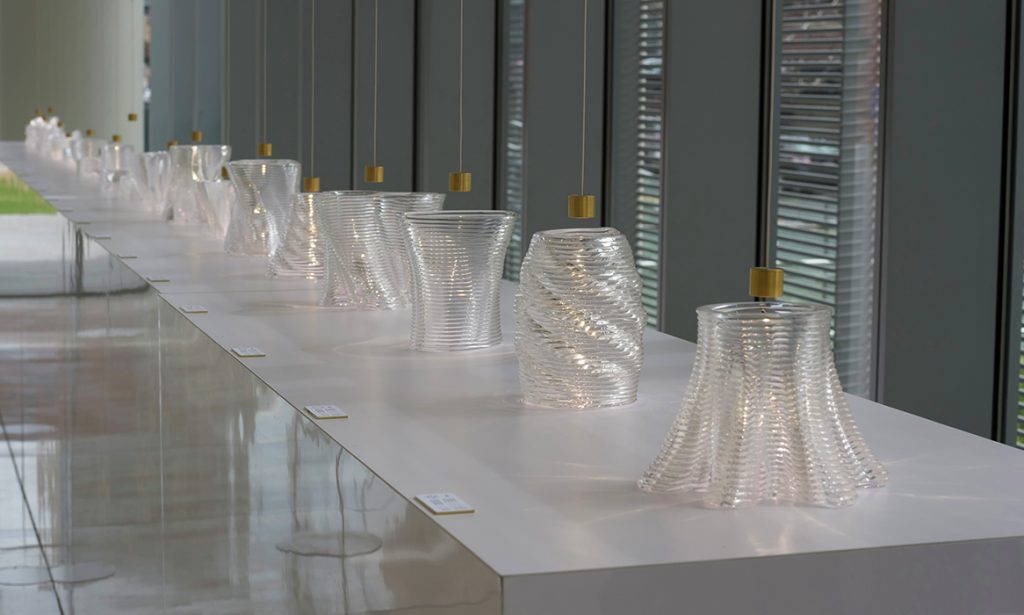In fact a group called Mediated Matter, founded and directed by a woman most of you are likely familiar with because of her incredible use of 3D printing in her art, Neri Oxman, has teamed with MIT’s Department of Mechanical Engineering, Wyss Institute and MIT’s Glass Lab to develop an advanced process of precise glass 3D printing.
“Glass‐based materials hold the potential to provide particular value in the additive manufacturing field due to their hardness, optical qualities, affordability and availability,” they write.
Through a project called G3DP, the team–which includes John Klein, Michael Stern, Markus Kayser, Chikara Inamura, Giorgia Franchin, Shreya Dave, James Weaver, Peter Houk and Prof. Neri Oxman–has utilized the cutting edge technologies of today along with the traditional age-old glass making tools of yesterday to create incredibly intricate 3D printed glass structures.
The way the machine works is actually quite simple. The top of the printer is basically a small kiln, which the user is able to place glass into. The kiln fires up and reaching a temperature of approximately 1900°F is easily able to melt the glass placed within. The lower section of the printer is made up of an alumina-zircon-silica nozzle, which has a similar function to that of a typical hotend on a desktop FDM 3D printer. Molten glass is then funneled down from the kiln and through the nozzle as it’s extruded onto a build platform to slowly cool and harden. When they want the glass flow and printing to stop, all they have to do is lower the temperature of the nozzle by using compressed air.The frame of the printer is constructed out of 80/20 aluminum stock and square steel tube. They used three independent stepper motors and a lead screw gantry system and drivers which were controlled via an Arduino and a RAMPS 1.4 Arduino shield. The movement system is very similar to any Cartesian-based 3D printer on the market today that you are likely familiar with.
In samples that the researchers had printed, each layer of printed glass had a height of approximately 4.5mm and a width of around 7.95mm on average. Additionally the prints were incredibly accurate as explained in the September 2015 issue of 3D Printing and Additive Manufacturing:“The deposition of the glass layers, however, appears to be highly precise: the deviation of the filament centers from the centerline was 0.18 mm ± 0.13 mm over the analyzed section (or ca. 2.25% of the total wall thickness). The maximum deviation observed was 0.42 mm. Therefore, a conservative tolerance of 0.5 mm could be considered for the fabrication of glass printed objects using this approach.”
With a highly accurate platform for fabricating intricate glass structures, there are numerous applications for such a device, and as research continues on the G3DP project it will be interesting to see what industries take note of this 3D printing process besides just artists like Oxman.
If you are interested in seeing some of the printed glass pieces in person, they will be on display next year in an exhibition at the Cooper Hewitt, Smithsonian Design Museum. Let us know your thoughts on this awesome process in the 3D Printed Glass forum thread on 3DPB.com. Check out the video below provided by Mediated Matter showing the printer in action:
[Researchers Include: John Klein, Michael Stern, Markus Kayser, Chikara Inamura, Giorgia Franchin, Shreya Dave, James Weaver, Peter Houk and Prof. Neri Oxman.]Subscribe to Our Email Newsletter
Stay up-to-date on all the latest news from the 3D printing industry and receive information and offers from third party vendors.
You May Also Like
3D Printing Webinar and Event Roundup: May 5, 2024
We’ve got a busy week of 3D printing events ahead of us, in Texas, Florida, Washington, D.C., Shanghai, and more. Webinar offerings will cover medical models, PolyJet 3D printing, additive...
High Stakes, High Speed: KVG Acquires 15 Nexa3D HSE 3D Printers to Boost Military Tech
As 3D printing increasingly intersects with defense and military logistics, a new partnership between Nexa3D and mission support logistics firm KVG stresses the growing importance of this technology in strategic...
Construction 3D Printing CEO Reflects on Being Female in Construction
Natalie Wadley, CEO of ChangeMaker3D, could hear the words of her daughter sitting next to her resounding in her head. “Mum, MUM, you’ve won!” Wadley had just won the prestigious...
3D Printing News Briefs, February 17, 2024: Shot Blasting, Service Bureaus, & More
In today’s 3D Printing News Briefs, we’re starting out with post-processing, as SKZ Würzburg is using a shot blast system from AM Solutions for its research. Moving on to business,...



![[Image: Chikara Inamura]](https://3dprint.com/wp-content/uploads/2015/08/gl4.png)
































